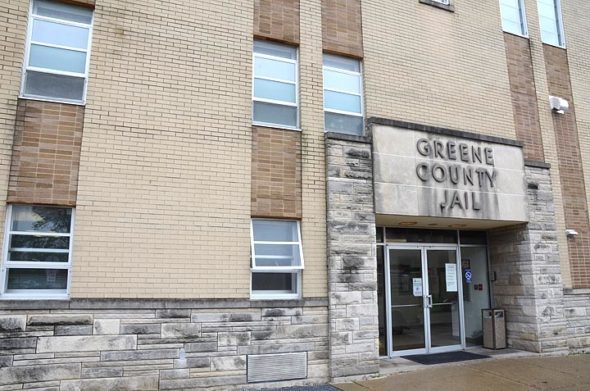Greene County— Jail options considered
- Published: May 9, 2019
Inside/Out
The first in a series of articles looking at the proposed expansion of the Greene County Jail, and the economic, social and human issues surrounding incarceration in the county.
• Read the second, third, fourth and fifth articles in this series.
When villager Don Hollister toured the Greene County Jail in downtown Xenia as part of a citizen group a year ago November, he was shocked by how stark it was.
“My clearest impression looking at the barred cells was that it seemed out of a movie,” he said. “It fit every stereotype I had of an urban jail.”
County officials are well aware of the jail’s defects, according to Greene County Sheriff Gene Fischer this week.
“We need to replace it,” he said. Aging infrastructure, overcrowding, an antiquated design and a lack of space for inmate programming were among the issues Fischer identified.
County officials are currently exploring options to replace the 50-year-old downtown jail with an updated and expanded facility. No plan has been settled on yet, but a final report is due out any day from the consultants hired by the county to develop design options for the project, according to County Administrator Brandon Huddleson this week.
Last summer, the Greene County Board of Commissioners hired Omaha, Neb.-based architectural, engineering and consulting firm HDR to assess the county’s existing jail and criminal justice system, and develop design options for a new facility to better meet current and future corrections needs. At a total cost of $177,000, that work is nearly done, Huddleson said.
Based on figures from previous phases of HDR’s study, a new jail would likely cost Greene County between approximately $50 to $70 million. The county expects to fund the facility through an increase in county sales tax, according to Huddleson. Any sales tax increase for the purpose of building a new jail would be put on the ballot, potentially as early as next November.
“I would anticipate putting the issue in front of voters,” he said.
Several area citizens who have been following the county’s plans agree that a new jail is needed.
“It’s a 50-year-old jail and it looks like it,” Wendy Dyer, of Bellbrook, said this week. Dyer was another member of the citizen group that toured the jail a year-and-a-half ago. While she wasn’t shocked by conditions in the jail, she was dismayed by inmates’ lack of privacy.
“Everybody deserves more dignity than that space provides,” she said. “We need a new jail for practical and humane reasons.”
However, Dyer worries that a major county investment in a new jail will increase incarceration rates in the county, which are currently lower than many surrounding counties, according to figures compiled by HDR. And she fears that less money will be available to treat substance abuse and mental health issues outside of jail settings. Studies widely show that substance abuse and mental illness are pervasive among incarcerated people.
“If they build it, will they fill it?” Dyer asked. “Is this how we should be addressing our mental health and addiction crises in the county?” she added.
This is the first of a series of articles in the News that will look at different aspects of the proposed new county jail. The present article provides an overview of the existing county jail system. Future articles will take a closer look at proposed jail options and examine topics including county inmate demographics and outcomes, the overlap between drug addiction and mental illness and incarceration and alternatives to incarceration being used in other communities.
Existing county jail facilities
Greene County runs two detention facilities for adults. The first is Greene County Jail, a maximum-security facility located on Market Street in downtown Xenia that houses felony inmates and female offenders. That facility has a total capacity of 146 beds. The second is the Adult Detention Center, or ADC, a primarily minimum-security facility built in 2000 and located about three miles away on Greene Way Boulevard. The ADC houses lower-level offenders, and has a capacity of 236 beds.
Since 2002, the county has run a 55-bed residential drug and alcohol rehabilitation program called Greene Leaf. The female portion of the program operates at the downtown jail, while the male portion is housed at the ADC.
The downtown jail is chronically overcrowded, according to Sheriff Fischer. Under a federal consent decree since 1989, when inmates at the time sued the county because of overcrowding, Greene County Jail housed an average daily jail population in 2017 of 138 inmates, about 11 percent above the jail’s maximum “functional capacity.” (This is the level at which the jail is considered to be most efficient and safe.) The jail has been at or above functional capacity between 2012 and 2017, according to information compiled by HDR, which looked at those six years.
By contrast, the ADC is well under functional capacity, with a 2017 average daily population of 160 inmates, 20 percent below the functional capacity maximum. This has been true for all of the six years the HDR study examined.
According to Sheriff Fischer this week, the downtown jail is a “1960s type” facility whose design is obsolete. He cited safety issues for prisoners and staff, as well as a lack of space to conduct prison programs and limited access to the outdoors for inmate recreation.
“It’s 50 years old. Corrections facilities have moved on,” he said.
Fischer said that the plan he would like to see would be one that combines the downtown jail, the ADC and the sheriff’s offices — a 1910 building not designed for law enforcement — into one structure on county land at the ADC site. The existing adult detention center could be repurposed for drug and alcohol rehabilitation operated by an outside service provider, he added.
“This isn’t just a jail project, it’s a whole facilities project,” he said.
Role of county jails in Ohio
County jails are run by the county sheriff’s department, as spelled out in the Ohio Revised Code. These incarceration facilities are distinct from state prisons, according to Buckeye State Sheriffs’ Association Executive Director Bob Cornwell. All people arrested in a county are brought to the county jail until they post bond or bail or go to court. The county jail is also where people serve out sentences for minor crimes, typically nonviolent violations, he said. People can serve up to one year per charge in a county jail, he added. By contrast, state prisons are for individuals serving longer sentences for more serious crimes.
As a result, county jails contain lots of different types of offenders and experience high turnover. In Greene County, for example, the average county jail stay in 2017 was 23 days, according to information compiled by consulting firm HDR. The average daily jail population during that same year was 283 people, while the total jail admissions — the number of arrested people who were processed by the county jail — was 4,459 individuals.
High turnover and the wide range of types of crimes represented in the population held in the county jail poses challenges for county sheriffs, according to Cornwell.
“You can’t put people with minor traffic violations with those accused of murder,” he said.
Appropriately housing individuals accused of, or serving time for, different types of crimes is a challenge in Greene County, according to Fischer.
“Last year, we had seven people in the Greene County Jail under indictment for murder,” Fischer said. While admittedly an unusual scenario, he said the county will always have “really bad offenders that have to be housed differently than those who’ve just made a mistake.”
Cornwell highlighted the impact of a state program called Targeted Community Alternatives to Prison, or T-CAP, which returns nonviolent felons to local communities for community-based substance use monitoring and treatment programs and other services. Some of those individuals end up in county jails, he said.
“When they violate terms and conditions for seeking treatment, they come back to our house,” he said.
Sheriff Fischer said Greene County has seen an increase in the number of people incarcerated for fourth- and fifth-degree felonies in the county jail system.
“The state is pushing them back to the county jail,” but not necessarily with the funding to allow counties to handle the influx, he said. Certain drug counts are classed as fourth- and fifth-degree felonies in Ohio.
Impact of opioids and other drugs
Perhaps the biggest factor affecting county jails in Ohio and around the country is the opioid epidemic. “America’s county jails are struggling to adjust to an opioid health crisis that has turned many of the jails into their area’s largest drug treatment centers,” according to an April 24, 2019, report on NPR.
Cornwell said that Ohio’s county jails aren’t equipped to deal with the influx of people addicted to opioids and other drugs who need help managing withdrawal symptoms during their period of incarceration and getting access to addiction and mental health services while in jail.
“County jails don’t have the time to dedicate to long-term fixes,” he said.
Cornwell estimated that about 60 percent of Ohio’s county jail population is struggling with addiction or mental health issues, with the two often overlapping. The population of women in jail is also rising as a result of the state’s drug crisis, he said.
In Greene County, women make up 30 percent of the inmate population, according to statistics cited by HDR. At twice the national average, that number is “exceptionally high” and common in areas with significant opioid abuse, according to the consultants’ report.
Drug crimes are the fourth most common charge category in the county jail, according to the HDR report, while the leading charge category, property crimes, is widely agreed to be fueled by drug addiction.
Addiction is a big issue in Greene County jails, Sheriff Fischer agreed. The county purchased and installed a body scanner for opiates at the jail about two years ago, after a fatal overdose there in March, 2017. Fischer said the jail sees “so many overdoses” and the scanner is necessary “to protect [inmates] from themselves.”
Across Ohio, county jails are responding to the drug crisis by expanding or rebuilding their facilities, adding in-jail treatment programs and partnering with other county agencies and community groups that provide addiction and mental health services, according to Cornwell.
In our part of Ohio, Warren, Franklin and Montgomery counties are among the communities building or planning new county jails, according to a March 4, 2019, article in the Dayton Daily News.
With the new jail project, Greene County will be taking all of these steps, County Commissioner Tom Koogler said this week.
He called the county’s goal a “transformational incarceration” that focuses on helping people, not just housing them.
“We’re not doing anything to fix the problem right now,” he said. “We need to commit a part of the jail to helping these people” through addiction treatment, mental health services and other programs. The aim is to improve inmates’ lives and productivity and reduce recidivism and related costs to the county, according to Koogler.
Area resident Wendy Dyer is both worried and hopeful about the county’s unfolding plans.
“I know I don’t know the right answer,” she said. “But I do know we’re talking about housing humans. … It’s important for us to get this right.”
The next article in the series will look at specific options being considered by the county for a new jail and the factors that go into those designs, as well as associated costs and funding approaches.
The Yellow Springs News encourages respectful discussion of this article.
You must login to post a comment.
Don't have a login? Register for a free YSNews.com account.

Parkinsons.jpg)














No comments yet for this article.